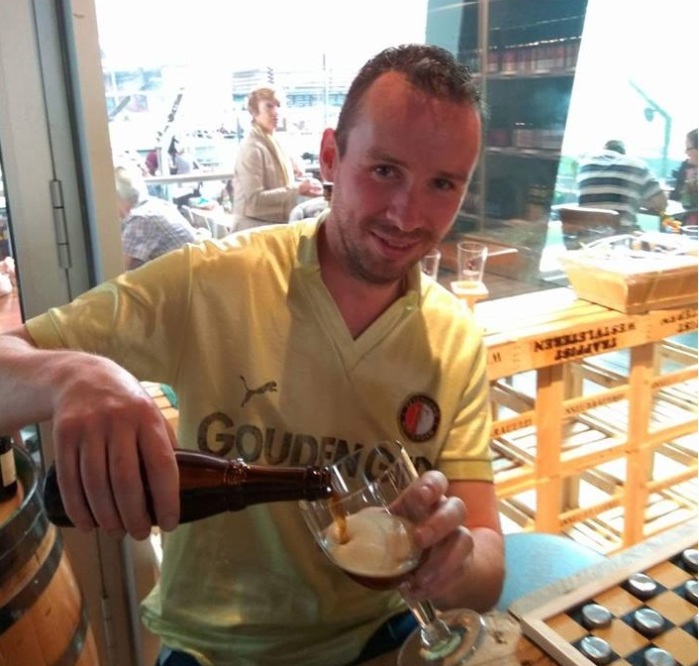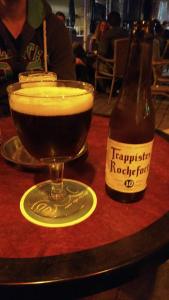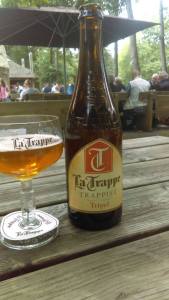
Drinking Westvleteren 12 in a bar in Rotterdam. The further away from the monastery the crazier the prices of ‘the best beer in the world’ can get.
While the is gaining territory worldwide people in many countries realize what they have been missing and look at Belgium with envy. This small multilingual country might struggle to do anything a Western European state in the 21st century is expected to, but they sure know how to make beers. In a world that until recently was largely dominated by terrible mass-produced brews the Belgians kept their amazing craft beer scene alive. Not in the last place because of the knowledge and skills of the many monks who populated the thin strip of land between dechristianized France and protestant Holland. Basically the French Revolution made Belgium the undisputed beer capital of the world.
Dechristianization in France
When the French Revolution started in 1789 Catholicism was the official religion of the country. At that time around 6% of the total territory in France was owned by the church and the country was full of abbeys, monasteries and catholic schools and hospitals. The nuns, who made themselves useful for society as nurses and teachers, were still kind of accepted by the revolutionairs, but the monks were absolutely not. Louis-Sebastien Mercier wrote in 1782 that Paris was “full of priests and tonsured clerics who serve neither the church nor the state, and were occupied with nothing but useless and trifling matters“. After the nationalization of the Catholic properties, many monasteries were destroyed and the land was sold to cover debts and finance further military campaigns. Under Napoleon Bonaparte this process continued in Belgium and Holland and for a few years it seemed that monastic brewing was a thing of the past in the Lowlands. However Napoleon’s defeat at Waterloo in 1815 opened new possibilities for the Catholic church in the Low Lands. Especially after Belgium claimed independence from predominantly Protestant Netherlands in 1830. In 1839 Belgium officially became an independent state and a safe haven for Catholic monks. Squeezed in between the French state that had demolished almost all its monasteries and the Protestants in the north.
Brewing monks
One of the ‘useless and trifling matters’ that Mercier described was apparently beer making. For centuries monks had studied a lot more than just the word of God. And with the exodus of Catholic monks France, although more a wine country, lost some of its most skilful beer recipes and brewers. The land of Gambrinus meanwhile thrived by the situation. Sure, the Low Lands from, Brittany and Normandy all the way up to the Northern coast of Holland were always more suitable for growing hops than wine, but now all knowledge settled in one place. Monasteries became the backbone of the much praised Belgian beer culture. The cross-fertilization between abbeys and local taverns and breweries led to a beer landscape the world had never seen. The large variety of great beers made it impossible to fool Belgians with cheap low-quality stuff, like happened in many countries in the 20th century. Even when monastic brews like Leffe, Grimsbergen or Hoegaarden went in business with one of the big companies they kept a more than decent standard. And then there are the 6 officially recognized Trappist beers in Belgium and another 2 just over the border in Catholic Holland. Since November 2016 Belgian beer is added to the Unesco cultural heritage list, making it a national symbol for its otherwise heavily divided people.
Trappist beers
Time to take a closer look at the Trappist beers in the Low Lands. The word Trappist doesn’t stand for a style of beer, but rather the order these Catholic monks belong to. Since the Order of Cistercians of the Strict Observance is a mouth full they are usually called after their house of origin: the La Trappe Abbey in Normandie. The Trappists maintain quite a strict lifestyle which abstains them completely from eating meat and when possible talking, what makes may believe they took a vow of silence. However their beers need little explaining, as they speak for themselves. In order label a brew as Trappist beer there are 3 simple requirements:
– The beer must be made inside the walls of a Trappist monastery. By monks or under their supervision.
– The brewery must be of secundary importance within the monastery. Devotion to God must still be the main goal.
– The brewery should not be profitable. It can cover the expences of maintenance of the buildings and grounds and the monks living, but everything more should be donated to charity.
Besides the 8 breweries in Belgium and the Netherlands there are 3 officially recognized Trappist beers from Austria, Italy and the United States, but now let’s have a look at the monasteries that provide the people in the Low Lands with their daily liquid bread.

Rochefort 10.
Westmalle
It’s impossible to find a better example of how the victims of the French Revolution left a mark on the Belgian beer scene than the Westmalle brewery. When monks of the Abbey Notre-Dame de la Trappe had fled the hostile scene in Normandie, they settled in a farm in De Kempen, near the city of Antwerp. As soon as the refugees officially got their own Trappist abbey in 1836 they started brewing beer as well. Sales started 20 years later, around the same time Westmalle introduced the first double beer (although a different recipe than the current Westmalle dubbel) in the world. Ever since these monks have inspired other beer enthousiasts with their excellent brews.
Westvleteren
Who knew in 1826 history was being made when a prior and 6 monks joined heremit and hops grower Jan-Baptist Victoor in the Woods of St. Sixtus? But a decent 190 years later, in the same place near the French border, the monks of the Saint-Sixtus Abbey are internationally recognized as the best beer makers in the world. Year after year Westvleteren 12 beats fierce competition. Perhaps the exclusive character helps, as the monks stay true to their Trappist vows and produce just enough beers to maintain their low living expences. The monks of St. Sixtus might not ask for much, but the further you go from the actual monastery, the crazier the prices for their beers. Luckily there’s also the commercial spinn-off St. Bernardus, which may not carry the Trappist mark, but it’s just as tasty and a lot cheaper.
Achel
The first dates back from the 17th century, but was destroyed in – here we go again – the French Revolution. However, in 1844 monks from Westmalle rebuilt the ruins and the new Abbey of Achel was born. From 1871 the monks of Achel became a Trappist order and beer brewing became one of their daily chores. Because of the German occupation in 1914 during World War I the monks had to leave their brewery and to make matters worse their oppressors stole their copper kettles to transform them into weapons. Since 1998 the monks of Achel started to pick up brewing again. With the help of monks from Westmalle and Rochefort they built a new brewery, that is active since 2001.
Rochefort
The fact that monks from Rochefort came to the aid of their brothers in Achel while building a brewery is not a surprise. This monastery was repopulated bij Trappists from Achel in 1887, after an absence of more than 100 years, since the monks of Rochefort had to abandon their monastery in 1794 because of you know who. In 1899 the new Trappists of Rochefort also started to brew beer again. With that they continued a tradition that dates back from 1595.

La Trappe Tripel.
Orval
Speaking of repopulation, the story of the monks of Orval is probably the most complicated of the Trappist monasteries. The monastery itself, that had a brewing tradition from the very start in the 12th century, was demolished in the French Revolution in 1793. It took till 1926 till a group of monks who originated from the French Sept-Fons Abbey moved in after an adventure in Brazil. Apparently the life in South America had not changed their taste for beer, cause 3 years later the was up and running. Orval became the first Trappist beer that was sold nationwide in Belgium.
Chimay
When 16 monks from Westvleteren populated the new Scourmont Abbey right on the French border in 1850 it looked like they would have a difficult task growing anything on this plateau. But somehow they managed pretty well and in 1862 they could tap their first beers. In the First World War the Germans also stripped this brewery of all its copper, and in WW II the same “friendly” neighbour destroyed the brewery, cause the troops used the monastery as barracks. But both times the monks of Chimay bounced back strong and kept producing beer.
La Trappe
About a century after almost all the monasteries were dismantled in the French Revolution a new threat came up for French monks with something called Laïcité. As more people called for secularization of church Catholic schools were targeted. The events of the previous uprising of anti-clericalism in mind a group of Trappists settled close to the Dutch city Tilburg and founded the Koningshoeven Abbey. Unlike the Protestant Northern provinces of the Netherlands the South, like Belgium, always remained Catholic and therefor wouldn’t mind a few beer brewing monks in the backyard. From 1884 the Koningshoeven brewery is active and the monks named their beer la Trappe, after the birthplace of their order.
Zundert
After the Trappists in the Koningshoeven Abbey were settled they believed it was safer for their order to start a second monastery in the region. They received a swampy piece of land near Zundert (birthtown of painter Vincent van Gogh), where they built the Maria Toevlucht Abbey in 1899. The monks always focussed on their cattle stock, but in the early 21st century this business simply couldn’t provide in their living expences anymore and since 2013 the abbey has its own Trappist beer called Zundert.
Revolutions
It’s an often heard question among beer enthousiasts: “Why does Belgium have so many good beers”. Many times this sentence is followed by an “It’s not fair” or similar words. But is it really? Maybe countries who chase peaceful monks off their lands don’t deserve to have good beers. Anyway, things are looking up everywhere in the world as the Craft Beer Revolution continues. Nothing new for Belgians though, they had great beers all along, with special thanks to the ‘French Anti-Craft Beer Revolution’.
Micky Bumbar
.
Related articles on Lords of the Drinks:
The Belgian/Dutch folk tale of Gambrinus, the king of beer
Lithuanian farmhouse ale, a craft beer tradition that survived Communism
The “All Beer Diet” German monks created for Lent Fast
Xenophon’s beer experience in Armenia
How the love for drinking made Russians choose Christianity over Islam
Gotta love a monk! And Belgium – a fine country indeed! Have a fabulous festive season, Micky, I will be raising several glasses in honour of you and Lords of the Drinks!
Cheers!
Lucy
LikeLiked by 1 person
Thank you so much Lucy! Have yourself some wonderful holidays as well and a very happy and prosperous 2018!
Cheers,
Micky
LikeLiked by 1 person
I love Trappist beers! Around the Holiday’s is the best around my area because they will come out with variety packs of them and they are much more accessible. Very full bodied, full flavoured beer! YUM!
LikeLiked by 1 person
True story. Well, I live 4 kilometers from the La Trappe brewery and all the Belgian ones are pretty easy to get in this area close to the border as well, so the season doesn’t matter that much for me. I do realize I’m a lucky bastard though.
Cheers,
Micky
LikeLiked by 1 person
So.. what you’re saying is that I should become very good friends with you so you can send me beer all the time?? ;p
LikeLiked by 1 person
Haha that’s an option. Oooooor you can come this way and we can do “charity work” in the bars of these monasteries till we saved the souls of everyone in our entire family trees. 😉
LikeLiked by 1 person
Damn Straight! ….I mean, Amen. Lol!
LikeLiked by 1 person
Haha that’s another sin to wash away with holy water, hops, yeast and a few other ingredients.
LikeLiked by 1 person
Cheers holy monks!
LikeLiked by 1 person